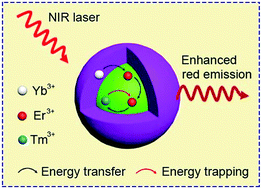A novel strategy for markedly enhancing the red upconversion emission in Er3+/Tm3+ cooperated nanoparticles†
Abstract
A rare-earth-based upconversion nanocrystal that exhibits anti-Stokes nature has attracted worldwide attention due to its unique physical properties. In this work, a novel core–active shell upconversion nanocrystal (NaErF4:Tm@NaGdF4:Yb) which emits super-bright red emission upon 980 nm near-infrared (NIR) laser excitation is presented. The Er3+ ions act as both sensitizers and activators to enable an efficient upconversion process of core nanocrystals. To mitigate the luminescence quenching caused by the energy migration between the Er3+ ions and internal lattice defects, an energy trapping center of Tm3+ was introduced into the core to confine the energy of Er3+ through an energy back transfer (Er3+ → Tm3+ → Er3+) pathway. After that, an active shell of NaGdF4:Yb was grown on the core zone to simultaneously enable the efficient energy transfer from NIR photons to the upconverting zone and suppress the luminescence quenching caused by surface defects and surface associated ligands. It is worth noting that both the Tm3+ and active shell can enhance the red to green (R/G) ratio of the Er3+ emission, thus resulting in an ultra-bright red emission with high purity. The core–active shell nanoparticles possess more intense (∼20 times higher) emission intensity than core–inert shell nanoparticles (NaErF4:Tm@NaGdF4), and their quantum yield reaches as high as 3.71%. This finding paves a convenient way to obtain red-emissive upconversion nanocrystals with high purity for special applications.

- This article is part of the themed collection: Editor’s Choice: Progress in singlet fission and photon upconversion


 Please wait while we load your content...
Please wait while we load your content...